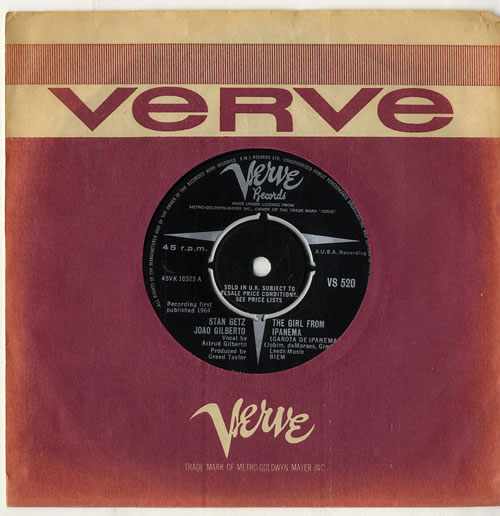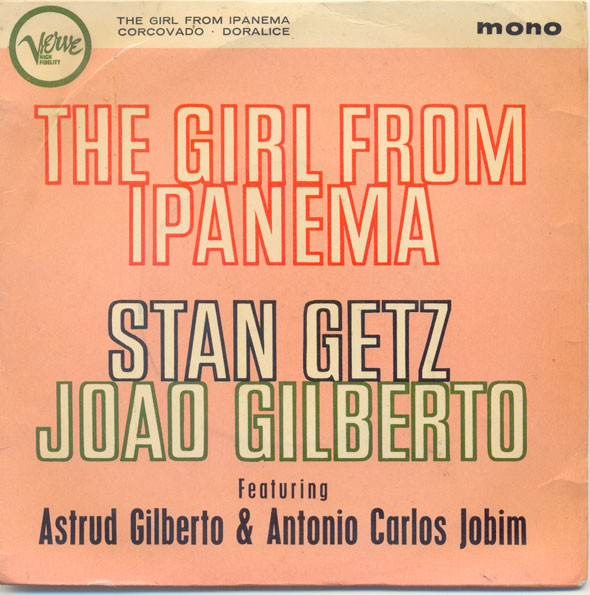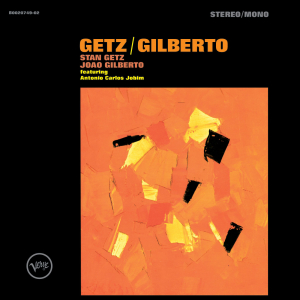The Girl from Ipanema
Bossa Nova culminated in 1962 with The Girl from Ipanema, its most well known song. When the song became a world hit in 1964, Bossa Nova had already died. But it left Brazilian music changed forever.
The Girl from Ipanema
Tom Jobim and Vinícius de Moraes would often sit with a cold chope (draught beer) at Bar Veloso (today Garota de Ipanema, see picture above) in Ipanema, at the corner of Rua Montenegro (today named Rua de Vinícius de Moraes, see map below) and Rua Prudente de Morais. In Rua Montenegro 22, on the opposite site between Rua Prudente de Morais and the beach, lived a tall 17 old girl by the name of Heloísa Eneida Menezes Paes Pinto, known as Helô. She would walk past the bar every day on her way to or from school gracefully swaying with her long black hair flowing free. After school, she would go to the beach in her bathing suit revealing her beautifully golden suntanned body. Sometimes she would even enter the bar to buy cigarettes for her mother. But in spite of the immense attention she attracted from the male guests, she never deigned anybody a look.
This would be the inspiration for one of the best known songs in the world. Tom’s melody imitates her gently gracefully swaying gait, which Vinícius describes in the A piece. The B piece turns into a mood of reflection, where Vinícius on the one hand praises her beauty which makes the world smile at turning more beautiful because of love, but on the other hand feels isolated and sad by the thought that the beauty passes by alone and does not exist there just for him.
The melody had started life in 1961. Together with other songs composed then, it was scheduled to be included in a musical comedy called Blimp. However, the show was never realized. Looking at the song again, Tom and Vinícius wanted to add lyrics, and Vinícius wrote a first version called “Menina que passa”, but neither of them was quite satisfied. The inspiration for the final version then came one afternoon in 1962 at Veloso, when they saw Helô pass.
O Encontro au Bon Gourmet
The song was presented for the first time in public in 1962 at a show at the small restaurant Au Bon Gourmet in Avenida Copacabana. This would be the first and only time the three major forces of bossa nova performed together: the composer and piano player Tom Jobim, the great poet Vinícius de Moraes, and João Gilberto, the man who invented the bossa nova guitar beat and, as the coolest singer ever heard, arguably the greatest interpreter of bossanova. They were accompanied by the vocal group Os Cariocas, Otávio Bailley on bass and Milton Banana on drums.
The show launched two other songs written for Blimp: the bossa nova classic “Só Danço Samba” and “Samba do Avião” (written by Tom alone); it also launched other new songs indicating that the song writing partnership between Tom and Vinícius was coming to an end: “Samba da Benção” and “O Astronauta”, both of which Vinícius had written with his new partner Baden Powell.
The show was probably the peak of bossa nova. It was planned to run for one month, but because of the huge interest it was extended for another two weeks. A couple of sets were recorded. In 2004 Daniella Thompson, on the basis of the tapes, wrote an informative review O Encontro au Bon Gourmet of the disc that no one reviewed, because it was never released. Among the things she reported is the introduction to the new song “Garota de Ipanema”, where João, Tom, Vinícius and João again exchange lines about each of them being needed for performance of the song, whereafter they all join in and sing the song together. There is a deep truth hidden under the fun, and hte song is clearly the highlight of the show. Eventually, the disc was released in 2014.
Recordings
The first to record the song in the studio was Pery Ribeiro. He heard it at the Bon Gourmet and became so excited that he went to the studio next day to record it. Soon after, it was recorded by Tamba Trio. These two recordings were released at the same time in January 1963. Os Cariocas also recorded a version which may have been released already in 1962. Later it was recorded by Claudette Soares. But of course, it was still another version, which made the song a world hit, claimed to be the second most performed song ever after “Yesterday” by The Beatles: the version by Stan Getz and João Gilberto with English vocal by Astrud Gilberto, recorded in March 1963.
Bossa nova had gradually attracted more and more attention in the US. Not least jazz musicians became excited about this new cool style of music, which contained the same harmonic sophistication as jazz, but different chord pregressions with very beautiful melodies. The release of Jazz Samba by Charlie Byrd and Stan Getz in April 1962 created a true bossa nova craze. It was only a faint reflection of authentic bossa nova, but the album got immensely popular, not least because Getz’ take on Jobim/Mendonça’s fascinating melody “Desafinado”. In August 1962, Getz recorded Big Band Bossa Nova, arranged by Gary McFarland, with four Brazilian tunes and four originals by McFarland.
The interest sparked a famous bossa nova concert in Carnegie Hall 21 November 1962, where a large program of Brazilian musicians, among them Tom Jobim and João Gilberto, presented the real thing to the American public. The day after the concert, João signed a recording contract with Verve. A couple of days later, João and Tom met Stan Getz and producer Creed Taylor from Verve for some initial rehearsals for the album. João demonstrated how to sing and play “One Note Samba”, which Getz had recorded on both the 1962 albums, but not gotten right.
Before the sessions started in March 1963, Verve recorded Jazz Samba Encore! by Stan Getz and Luiz Bonfá with participation of Tom Jobim and Bonfá’s wife Maria Toledo in February. The recording of Getz/Gilberto, which yielded the definitive version of “The Girl from Ipanema”, involved Tom Jobim on piano, Milton Banana on drums; the bass is sometimes credited to Tommy Williams, and sometimes to Sebastião Neto. Whereas the melodies of bossa nova inspired Getz to some of his most lyrical playing, he had troubles with the relaxed flexible rhythm played by João and Milton Banana.
As is well known, João’s wife Astrud was invited to sing English verses of “The Girl from Ipanema” (by Norman Gimbel) and “Corcovado” (by Gene Lees). After her singing proved a success, everybody involved in the session claimed that it was his idea. But she was not “discovered” by that occasion. She had performed in public by one bossa nova event, but moreover, she sang at many informal gatherings and practiced hard at home under the supervision of her perfectionistic husband with the ambition to start singing professionally. See her own account here.
Creed Taylor sat on the tapes for a long time. At first, he did not want to compete with Jazz Samba, which was still selling well. In the meantime, in May, he recorded and released The Composer of Desafinado Plays, an instrumental album by Tom Jobim, which contained a version of “The Girl from Ipanema”. Later he noticed that Jazz Samba Encore! was only selling decently. In the end, he became convinced that the best way to pave the way for the gold in his hands was Astrud’s English vocal. In December 1963 he released a single version, where João’s singing and a large part of the sax solo was cut out to obtain a suitable length. It sold more than two million copies. The LP was finally released in March 1964.
Since then, there have been countless recordings of the song. One of the best known saw life in 1967, when The Voice, Frank Sinatra himself, recorded it with Tom Jobim playing guitar in an arrangement by Claus Ogerman, who also had arranged on The Composer of Desafinado Plays.
Garota de Ipanema – 10+ Important Versions
- Antônio Carlos Jobim, Vinícius de Moraes & João Gilberto (1962) From the Bon Gourmet. The pulsating bass line gives the debut version a samba feeling, and Tom’s comping is slightly jazzy. João’s bossa nova guitar beat is hardly audible, and the joint singing is also more samba than bossa nova.
- Pery Ribeiro (1962) This version borrows from the bass line of the Au Bon Gourmet version and add further samba characteristics to the arrangement. Pery Ribeiro is not a bossa nova singer, but in line with the arrangement he endows the song with a lot of energy.
- Tamba Trio (1962) This version also borrows from the bass line from Au Bon Gourmet. The trio speeds up the tempo and adds some original vocal harmonies.
- Os Cariocas (1962) This version may have been released before the others. The focus is on vocal harmonies, which was not part of the Bon Gourmet version.
- Stan Getz, João Gilberto & Astrud Gilberto (1963) This time, the arrangement is dominated by João’s guitar and has a clear bossa nova feeling. He starts with a nasal legato humming, at the same time hinting at the melody and the lyrics about the girl’s swaying gait. João sings very low and laid back. Interestingly, the bass is still important providing a contrast to João’s phrasing. Next comes Astrud, who sings the English lyrics slighty louder. Her accent seems to underline her shyness and conveys a charming impression of innocence; but at the same time she is cool, confident and unapproachable. Clearly, she is the girl from Ipanema. Then Getz takes a chorus blowing at full strength. Jobim’s piano solo cools things down again, and Astrud comes back and takes the song to a fade out.
- Stan Getz, Astrud Gilberto & João Gilberto [single version] (1963) There is deep irony in the fact that the American public needed to be introduced to such an amputated version. It cut away João’s singing, which with all respect for Astrud was the greater art. It cut away Vinícius’ lyrics in favor of a very poor English version. Whereas Vinícius’ lyrics were concerned with the existential meaning of beauty and love, Norman Gimbel’s version reduced the song to a trivial love story. Moreover, Gimbel took away two syllables from the first line, thereby disrupting the melody’s imitation of the girl’s walk. He even wanted to skip the reference to ‘Ipanema’, but that was after all vetoed by Tom. Finally, Stan’s carefully build-up solo was reduced to a few disparate phrases. On top of it, the cuts are very clumsy made.
- Stan Getz, Astrud Gilberto & João Gilberto (1964) This is a live version from a concert in Carnegie Hall in 1964. Even though the setting appears somewhat casual, there is an intensity which in some respects eclipses the studio version. Unfortunately, Getz’ drummer Joe Hunt is completely lost in his attempt to follow João’s flexible rhythm. It makes a world of difference when João is backed his own rhythm group with Helcio Milito on drums in another part of the same concert.
- Antônio Carlos Jobim (1964) Instrumentals with economical and elegant orchestral arrangements by Claus Ogerman, allowing his beautiful piano playing to get the attention it deserves, would be the formula for Tom Jobim’s solo records, starting with this one. On this version of “The Girl from Ipanema” Tom uses a phrasing when introducing the melody of the A piece which was first heard as his solo on the Getz/Gilberto version and which he would use throughout his carreer. To my mind, it is a strange staccato phrasing which fits badly with the image of the girl’s swaying gait – compare with João’s legato phrasing. But on reflection, maybe Tom wanted to set up a rhytmic contrast to play a little with our expectations.
- Frank Sinatra & Antônio Carlos Jobim (1967) Even though Sinatra sang softer here than elsewhere, he is far from the coolness of João Gilberto’s singing. Still, he catches the melody well and his phrasing is impeccable. For Tom Jobim, this was the ultimate recognition. But it came at the cost of satisfying the prejudiced expectations of the American public by accepting the role of the guitar playing latin lover boy, which his singing in Portuguese only amplified, rather than that of an important gifted composer and piano player.
- Ella Fitzgerald (1981) From an album devoted to Jobim songs, this is a jazzy version, which underlines Ella’s swinging approach. But it seems far away from an understanding of the coolness of bossanova.
- Amy Winehouse (2011) Amy’s version is also jazzy. But the stripped down arrangement and her immensely musical free phrasing brings it somehow more in affinity with the ideas of bossa nova. I could do without the string machine, though, and the drum machine as well for that matter.
- Claudette Soares (1963) Claudette Soares started singing already in 1947 at the age of ten. She worked with many important musicians during the following years, but no-one wanted to record her. Around 1960 she left Rio for São Paolo, where she worked with the pianist Pedrinho Mattar and where she finally got recorded. The song (and her first LP) was recorded on Mocambo, a small label directed by Jonas Silva, the crooner of Garota da Lua who was replaced by João Gilberto. Soares’ version is an original arrangement, a freshly swinging and very jazzy interpretation of the bossa nova idiom. Information about the combo is nowhere to be found, but judged by the playing it could be Pedrinho Mattar and his trio.
There is a famous video from a live performance:
Frank Sinatra & Tom Jobim: “The Girl from Ipanema” (Jobim/de Moraes) 1967
What Happened to the Girl from Ipanema?
It was not until 1965 before Helô realized that she had been the inspiration for the now world famous song, when both Tom and Vinícius publicly revealed the story behind the song. By then, she was engaged with the engineer Fernando Abel Mendes Pinheiro, a man who came from a rich family and was good at beach volley. When they got married in 1966, Tom and his wife Thereza were padrinhos at the wedding. Helô’s husband and her father (an army general) were proud of the extreme public interest in the real girl from Ipanema, but still they wanted to keep her away from the public eye, which they managed to do for many years.
However, at a mature age, she started working as a TV hostess and a model. She was Brazilian Playboy Playmate in 1987, and again in 2003 with her daughter Ticiane. She also opened a boutique for beach fashion, which she naturally wanted to brand with the name “Garota de Ipanema”. In spite of the composers having praised her as their inspiration, their heirs as copyright owners sued her for misusing the name of the song. Public sympathy was clearly on her side, though, and eventually the court ruled in her favor.
What Happened after “The Girl from Ipanema”?
With the Getz-Gilberto version of “The Girl from Ipanema”, bossa nova seduced the world. But as indicated, in Brasil it was already on the decline, not least because Tom and Vinícius ended their partnership. Of course, others worked in the idiom after 1962. But many Brazilian musicians moved to the US, thereby translocating the center of bossa nova. The final blow would come when the military seized power in 1964. This would make more musicians leave for the US, and keep those who were already there for a longer time. But the coup would also kill the optimistic spirit inherent in bossa nova. Life became dominated by oppression, fear and censorship.
However, the light guitar with the syncopated beat and the harmonic sophistication would be a point of no return and stay with Brazilian music ever since. And every now and then bossa nova would pop up again in the musical landscape. João Gilberto, for one, would continue to work in the idiom throughout his career (although he would never himself call it ‘bossa nova’ but simply ‘samba’). But younger generations would also, from time to time, revitalize the genre.
30 Years After
In 1992, Tom and João met 30 years after the debut of “The Girl from Ipanema” at a concert in Metropolis and created a magic moment. João took up the introduction to “The Girl from Ipanema” from Au Bon Gourmet, as you can see here:
Tom Jobim & João Gilberto: “Garota de Ipanema” (Jobim/de Moraes) 1992













Great article! Interesting how the famous, single version takes away all the good stuff from the original Getz version. On the same note, can’t help but notice how Jobim by far outperforms Sinatra in the clip! Things get lost in translation indeed…